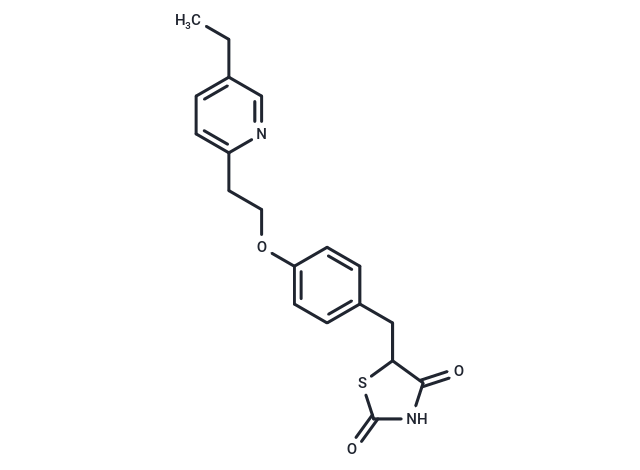Shopping Cart
Remove All Your shopping cart is currently empty
Your shopping cart is currently empty
Pioglitazone (U 72107) is a PPARγ agonist with EC50 of 0.93 and 0.99 μM on human and mouse PPARγ, respectively, and has selective and oral activity. Pioglitazone can be used in diabetes research.

| Pack Size | Price | USA Warehouse | Global Warehouse | Quantity |
|---|---|---|---|---|
| 5 mg | $35 | In Stock | In Stock | |
| 10 mg | $48 | In Stock | In Stock | |
| 25 mg | $63 | In Stock | In Stock | |
| 50 mg | $98 | In Stock | In Stock | |
| 100 mg | $143 | In Stock | In Stock | |
| 500 mg | $352 | - | In Stock | |
| 1 mL x 10 mM (in DMSO) | $50 | In Stock | In Stock |
| Description | Pioglitazone (U 72107) is a PPARγ agonist with EC50 of 0.93 and 0.99 μM on human and mouse PPARγ, respectively, and has selective and oral activity. Pioglitazone can be used in diabetes research. |
| Targets&IC50 | PPARγ (mouse):0.99 μM (EC50), PPARα (human):100 μM (EC50), PPARα (mouse):100 μM (EC50), PPARγ (human):0.93 μM (EC50), PPARδ (human):43 μM (EC50) |
| In vitro | METHODS: HT-1080, MDA-MB-231, and PC-3 cells were treated with Pioglitazone for 3 days, and target cell toxicity was measured using MTT assay. RESULTS: Pioglitazone did not affect cell growth at 100 μM. [1] |
| In vivo | METHODS: To investigate the effect of Pioglitazone on insulin resistance, Pioglitazone (10 and 30 mg/kg) was orally administered to ob/ob and adipo-/-ob/ob mice once daily for 14 days. RESULTS: Pioglitazone improves insulin resistance and diabetes, which may be lipocalin-dependent in the liver but not in skeletal muscle. [2] METHODS: To investigate the effect of Pioglitazone on cardiac remodeling, diabetic nephropathy rats were treated with oral administration of Pioglitazone (10 mg/kg) once daily for 4 weeks. RESULTS: Pioglitazone significantly reduced body weight (BW), cardiac hypertrophy, elevated blood glucose levels, and related dyslipidemia. [3] |
| Synonyms | U 72107 |
| Molecular Weight | 356.44 |
| Formula | C19H20N2O3S |
| Cas No. | 111025-46-8 |
| Smiles | C(C1C(=O)NC(=O)S1)C2=CC=C(OCCC3=CC=C(CC)C=N3)C=C2 |
| Relative Density. | 1.26 g/cm3 |
| Storage | store under nitrogen | Powder: -20°C for 3 years | In solvent: -80°C for 1 year | Shipping with blue ice/Shipping at ambient temperature. | ||||||||||||||||||||||||||||||
| Solubility Information | DMSO: 28.8 mg/mL (80.8 mM), Heating is recommended. Ethanol: < 1 mg/mL (insoluble or slightly soluble) H2O: < 1 mg/mL (insoluble or slightly soluble) | ||||||||||||||||||||||||||||||
| In Vivo Formulation | 10% DMSO+90% Corn Oil: 2 mg/mL (5.61 mM), Sonication is recommeded. Please add the solvents sequentially, clarifying the solution as much as possible before adding the next one. Dissolve by heating and/or sonication if necessary. Working solution is recommended to be prepared and used immediately. The formulation provided above is for reference purposes only. In vivo formulations may vary and should be modified based on specific experimental conditions. | ||||||||||||||||||||||||||||||
Solution Preparation Table | |||||||||||||||||||||||||||||||
DMSO
| |||||||||||||||||||||||||||||||
| Size | Quantity | Unit Price | Amount | Operation |
|---|

Copyright © 2015-2025 TargetMol Chemicals Inc. All Rights Reserved.